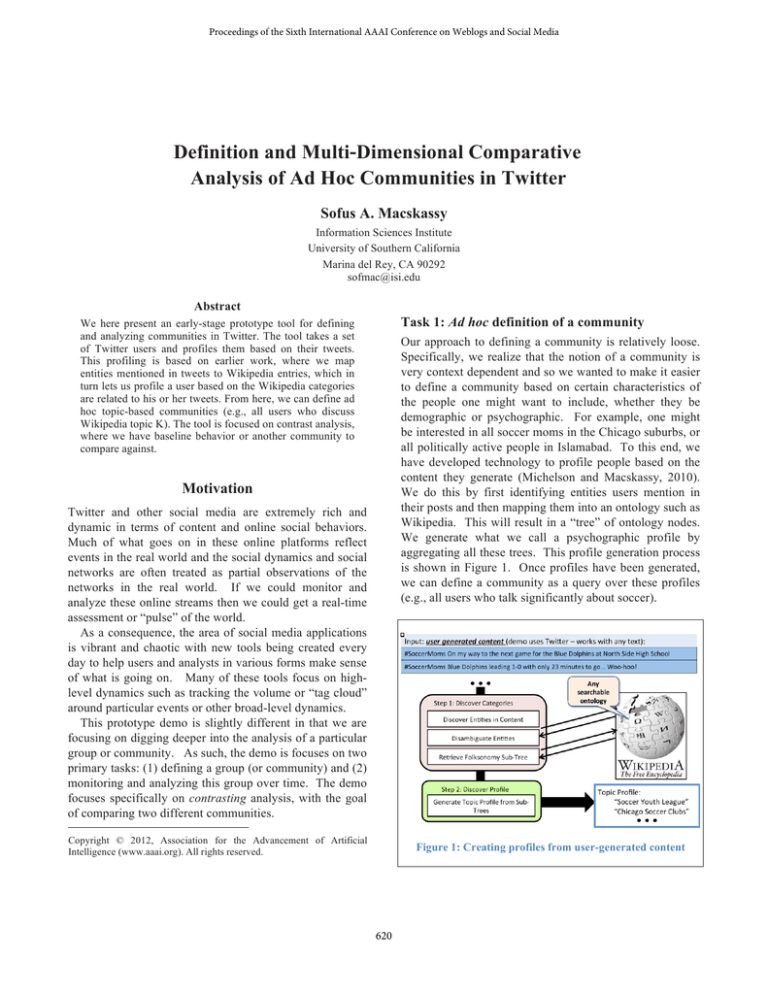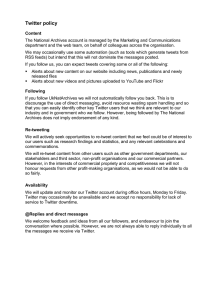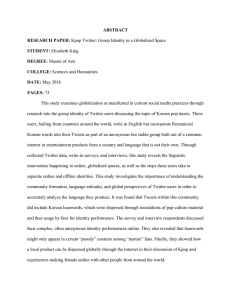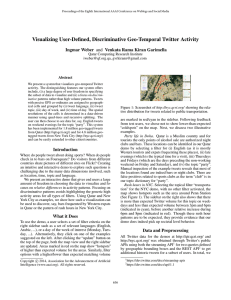
Proceedings of the Sixth International AAAI Conference on Weblogs and Social Media
Definition and Multi-Dimensional Comparative
Analysis of Ad Hoc Communities in Twitter
Sofus A. Macskassy
Information Sciences Institute
University of Southern California
Marina del Rey, CA 90292
sofmac@isi.edu
Abstract
Task 1: Ad hoc definition of a community
We here present an early-stage prototype tool for defining
and analyzing communities in Twitter. The tool takes a set
of Twitter users and profiles them based on their tweets.
This profiling is based on earlier work, where we map
entities mentioned in tweets to Wikipedia entries, which in
turn lets us profile a user based on the Wikipedia categories
are related to his or her tweets. From here, we can define ad
hoc topic-based communities (e.g., all users who discuss
Wikipedia topic K). The tool is focused on contrast analysis,
where we have baseline behavior or another community to
compare against.
Our approach to defining a community is relatively loose.
Specifically, we realize that the notion of a community is
very context dependent and so we wanted to make it easier
to define a community based on certain characteristics of
the people one might want to include, whether they be
demographic or psychographic. For example, one might
be interested in all soccer moms in the Chicago suburbs, or
all politically active people in Islamabad. To this end, we
have developed technology to profile people based on the
content they generate (Michelson and Macskassy, 2010).
We do this by first identifying entities users mention in
their posts and then mapping them into an ontology such as
Wikipedia. This will result in a “tree” of ontology nodes.
We generate what we call a psychographic profile by
aggregating all these trees. This profile generation process
is shown in Figure 1. Once profiles have been generated,
we can define a community as a query over these profiles
(e.g., all users who talk significantly about soccer).
Motivation
Twitter and other social media are extremely rich and
dynamic in terms of content and online social behaviors.
Much of what goes on in these online platforms reflect
events in the real world and the social dynamics and social
networks are often treated as partial observations of the
networks in the real world. If we could monitor and
analyze these online streams then we could get a real-time
assessment or “pulse” of the world.
As a consequence, the area of social media applications
is vibrant and chaotic with new tools being created every
day to help users and analysts in various forms make sense
of what is going on. Many of these tools focus on highlevel dynamics such as tracking the volume or “tag cloud”
around particular events or other broad-level dynamics.
This prototype demo is slightly different in that we are
focusing on digging deeper into the analysis of a particular
group or community. As such, the demo is focuses on two
primary tasks: (1) defining a group (or community) and (2)
monitoring and analyzing this group over time. The demo
focuses specifically on contrasting analysis, with the goal
of comparing two different communities.
Copyright © 2012, Association for the Advancement of Artificial
Intelligence (www.aaai.org). All rights reserved.
Figure 1: Creating profiles from user-generated content
620
Task 2: Contrasting analysis of communities
Once communities have been defined, we first show a list
of the users that make up each community; ranked by how
much content they have produced (see Figure 2).
From here, the user can then get a comparative analysis
of the two communities along a set of dimensions.
Figure 4: Showing topics of importance
Identifying topics of importance for each community
The next dimension of analysis is at the topic-level. We
analyze the topical concepts in each tweet in the given
community (where a topic is an ontological node), and
compute whether it is statistically more aligned with one or
the other community in a similar manner as we did with
the website comparison just described (again using a Ztest). A screen shot is shown in Figure 4.
Figure 2: Defining two communities of interest
Identifying web-sites of interest
In this analysis, we look at the websites the users from
each community link to and then identify three categories
of websites. We first de-reference all shortened URLs to
identify the real website, then compute statistics on linking
behavior from each community, and finally categorize a
website into one of three categories:
Ad Hoc Chatter Analysis
Often one would like to know what a community is saying
about a topic or entity. Our demo shows how one can
query on a keyword or phrase and it will on the fly
compute words which each community use in the context
of that phrase. We apply machine learning to learn to
categorize tweets and then extract the features (words) the
model uses to discriminate between the two. We then
cluster features and tweets to give users an overview of
their differences. (screen shot omitted due to space).
1) Unique: only one community links to that web-site.
2) Significant: one community links to the web-site
significantly more often than the other.
3) Neither: there is no statistically significant
difference in linking behavior.
Figure 5: Showing important topics over time.
Figure 3: Identifying web-sites of interest
If both communities link to a site, then we use a Z-test to
compute statistical significance. This is based on the size
of the communities and the number of users linking to the
website. Figure 3 shows a screen shot from the demo.
References
Michelson, M and Macskassy, S. A. (2010). Discovering Users'
Topics of Interest on Twitter: A First Look. Proceedings of the
Workshop on Analytics for Noisy, Unstructured Text Data (AND).
621









